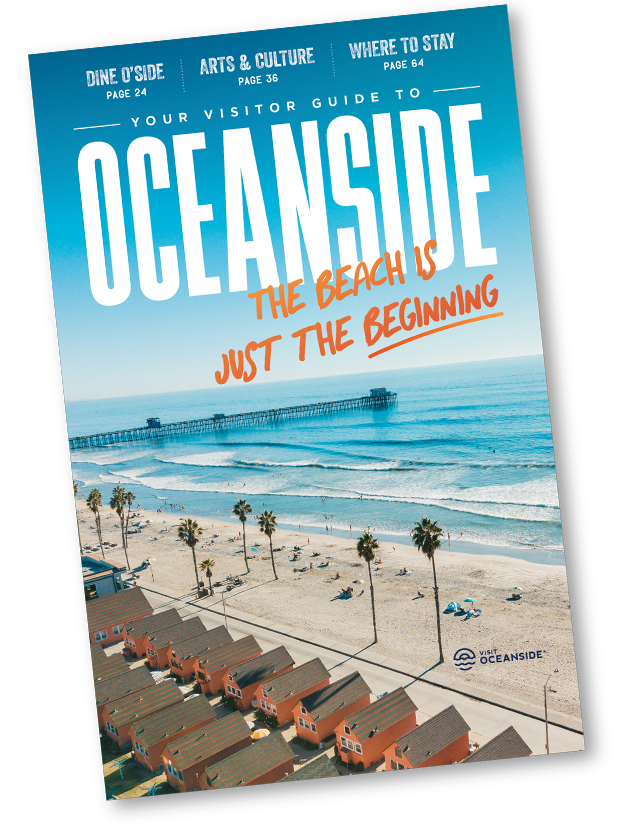By Kristi Hawthorne, O’sider and Director of the Oceanside Historical Society.
Oceanside’s Pier is iconic, a favorite landmark and one of the most photographed and visited features. Thousands enjoy Oceanside’s pier every year. Fishermen, tourists and locals stroll along the wooden planking and gaze into the ocean, just as Oceanside’s early citizens did over 130 years ago. Oceanside’s pier is a tradition, one that despite relentless waves, high tides and low funds managed to survive.
Remnants of our first pier are now buried. An occasional storm or low tide uncovers the rows of the old, weathered pilings (or what’s left of them). In fact, they just made an appearance in 2020. Few people know they are there or realize their significance.
The first pier, called a wharf, was located at the end of what is now called Wisconsin Street, first named Couts Street (after Cave J. Couts, Jr., surveyor of the original townsite).
Talk of a wharf began in 1887 when soundings were made. This was no “pleasure pier” for sightseers but intended to be a shipping port with a price tag of $30,000. The National City Record reported that the wharf would be 1,596 feet long, 50 feet wide and would accommodate “vessels drawing 25 feet of water.” If that wasn’t impressive enough, it went on to say that the wharf would be connected to the railroad! A color lithograph done in 1887 depicts the railroad spur leading to the pier “with a turn-around track for cars” and a large ship docked at the wharf.
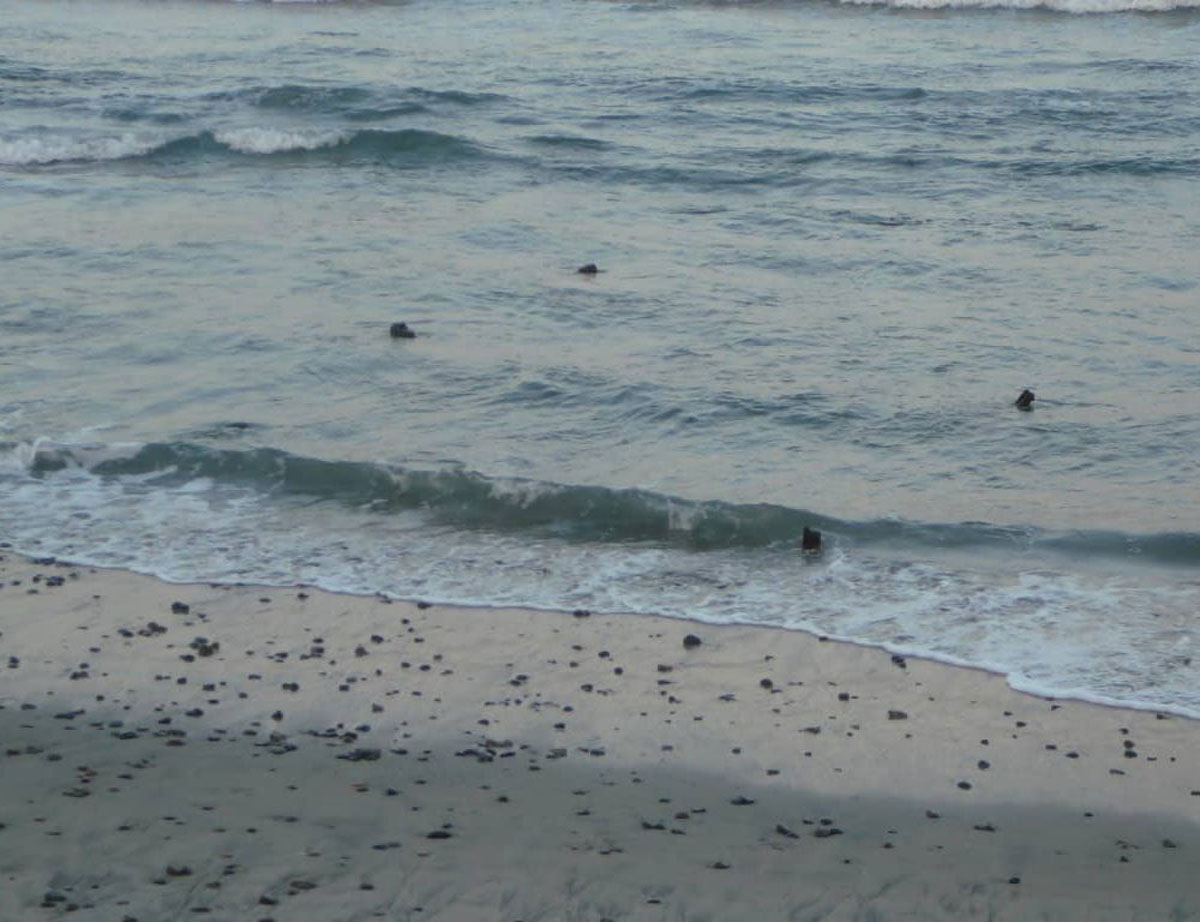
Pilings from the first pier at the end of Wisconsin Street in 2012
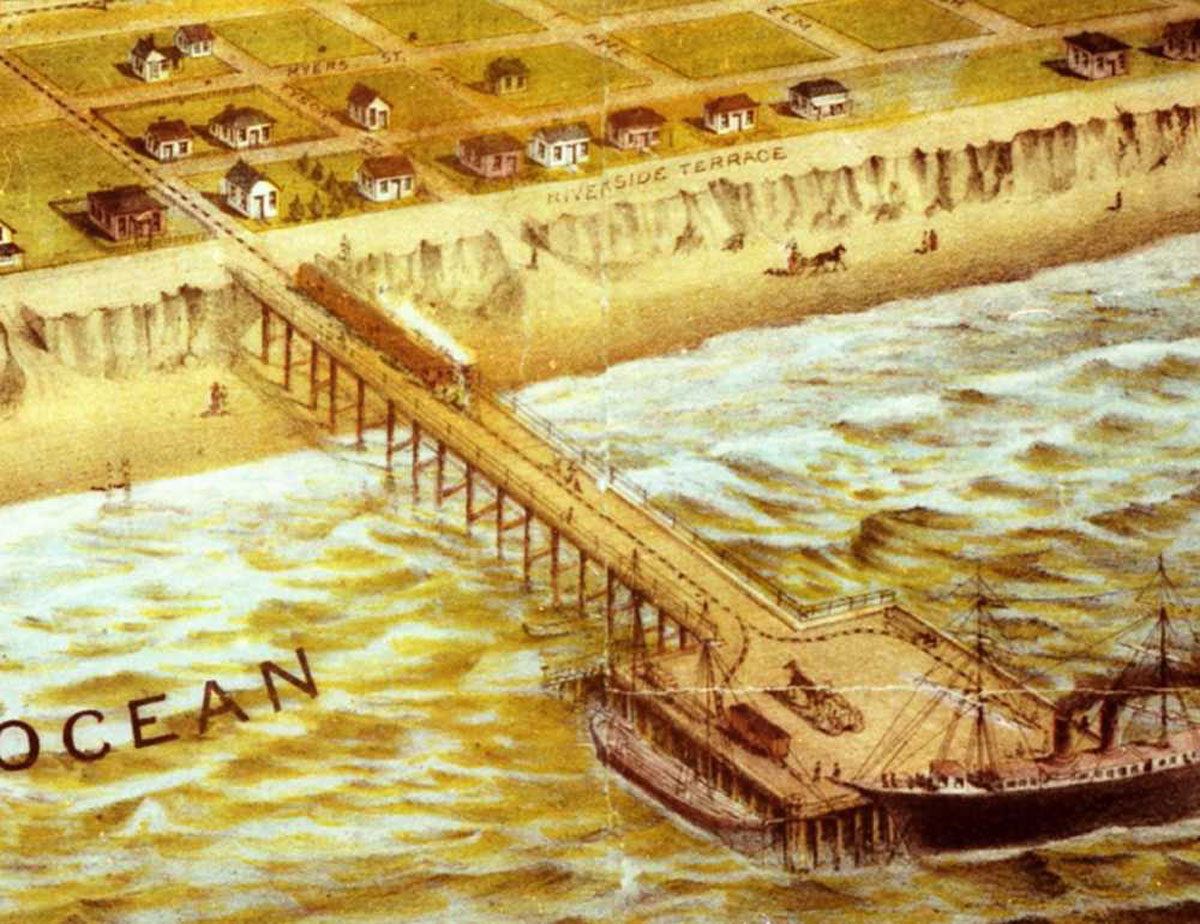
Portion of 1887 Lithograph depicting the railroad spur on the wharf (which never came to be). Photo from the Oceanside Historical Society Collection
The O’riginal Story.
On March 9th the South Oceanside Diamond reported: “Our citizens are determined to have a wharf. The plans have been drawn, money subscribed and it ought to be completed by July 4th.”
A year later, plans were drawn up for a more modest structure, without the railroad spur. The San Diego Union published the following: “A contract has been closed by the Oceanside Wharf Company, of Oceanside, for the building of a pier wharf at that place. It will be 1505 feet in length, will command a depth of 31 feet and the piles will be covered with paraffine paint and felt, and will be braced by iron sway bracing. The estimated cost of the structure is $35,000, and it is contracted to be completed in four months.”
Everyone was overly optimistic but the first piling wasn’t even driven into the sand until May 12, 1888. The new date for completion was extended to September.
Oceanside was a boomtown then – real estate speculators came in and bought large lots with the hope of becoming rich. Men with big ideas and great plans for the city poured in. Some left as quickly as they came, while many stayed and made decisions and impressions that are with us today.
One of these men, Col. Daniel H. Horne, Oceanside’s first president of the Board of Trustees, along with banker Charles Morrill, proposed enterprising if rather lofty ideas. They made rousing speeches about the future of Oceanside. They talked of the train, a Flume Company and the building of a wharf. Real estate agent J. Chauncey Hayes advertised one would be “wearing diamonds” if they invested in the local real estate. Men like Hayes, Horne and Morrill supported the wharf and even backed it financially. Supporters of the wharf claimed that Oceanside would rival San Diego, Los Angeles and San Francisco with the help of a wharf. Citizens rallied, eager to help. They pledged labor and money for the wharf project that would bring them wealth and prosperity.
The wharf fund was raised by subscription. $28,000 was pledged by Oceanside residents and businessmen. The amounts ranged from $10 to $5,000. One year later, however, less than half of these pledges were paid and citizens were urged to “step up” and pay their subscriptions.
The lumber for the wharf came by railroad but also by boat. It was floated to the shore and guided by skiffs. But it was not without trouble. On June 29, 1888, the South Oceanside Diamond reported: “The sea has been unusually high the past week and the Starbuck has been unable to land any lumber. On Wednesday the water ran so high that not even a boat could cross the breakers, and the Starbuck’s crew stayed beyond them. Bob Simpson, the champion swimmer, carried a message to the boat through the surging sea.”
Delivering the lumber was a slow process. Two weeks later the Starbuck was still delivering wharf materials through the surf “slowly but surely”. By June 20, 1888 work finally began but a new completion date of December 1st was announced.
The building contract was given to the Great American Bridge Company of San Francisco and its superintendent was J.P. Sheldon. By August 3rd the wharf was out 500 feet and fishing from it became the favorite pastime for residents.
The Diamond reported that another ship, the Olive S. Southard, had “unloaded 15,000 feet of lumber and 258 piles, which completes the amount of lumber required for the wharf.” Soon the wharf was stretching out at 1,000 feet.
Surely shipping vessels would be docking soon, people thought. With a wharf, the costs of goods such as strongly needed lumber would be reduced. Oceanside would become an important shipping port between Los Angeles and San Diego. Fifteen trains a day pulled into our train depot – count would soon begin of the steamers arriving at the wharf.
By the end of August, the wharf was out 1,340 feet. However, the wharf company ran out of “silver-coppered nails” and work was been suspended for 60 days. In October the wharf sat unfinished, out of nails and out of money. The South Oceanside Diamond printed the following poem:
The Wail of the Wharf
Alone I am left, half clad in the cold; My long feeble legs are bare to the wave.
The reason is, I suppose, no shares have been sold. And slowly I’ll find me a watery grave.
I haven’t the piles, as some people think, nor is it the climate that’s breaking me up;
My lungs are first rate but the needful chink those doubting shareholders will not put up
Another setback occurred in December of 1888 when a storm swept pilings and planks from the Oceanside pier and lumber was washed down to Carlsbad. Few people know that Carlsbad also had the makings of a small wharf, but the storm did greater damage to the Carlsbad wharf and it was completely destroyed. Unsympathetic, Oceanside citizens went to the beach and gathered the lumber from the Carlsbad wharf and used it for firewood!
Still determined, despite damage to its own wharf, Oceanside rallied and residents pledged 260 days of labor and donated a modest amount of money to finish the project. W. D. Frazee offered to begin work on the wharf each morning with much-needed prayer.
The completion deadline came and went. Wharf lumber was being used as a boardwalk to the South Pacific Hotel from the train tracks rather than for decking. “When will the wharf be completed?” was a question echoed in the columns of the newspaper and on the streets of Oceanside.
The February 1, 1889 edition of the South Oceanside Diamond ran a sketch of the wharf as it would appear by the new deadline: September 1890! But bit by bit, the wharf was being whittled away by heavy seas. The portion remaining intact was said to “answer one purpose admirably–that of a barnacle roost.”
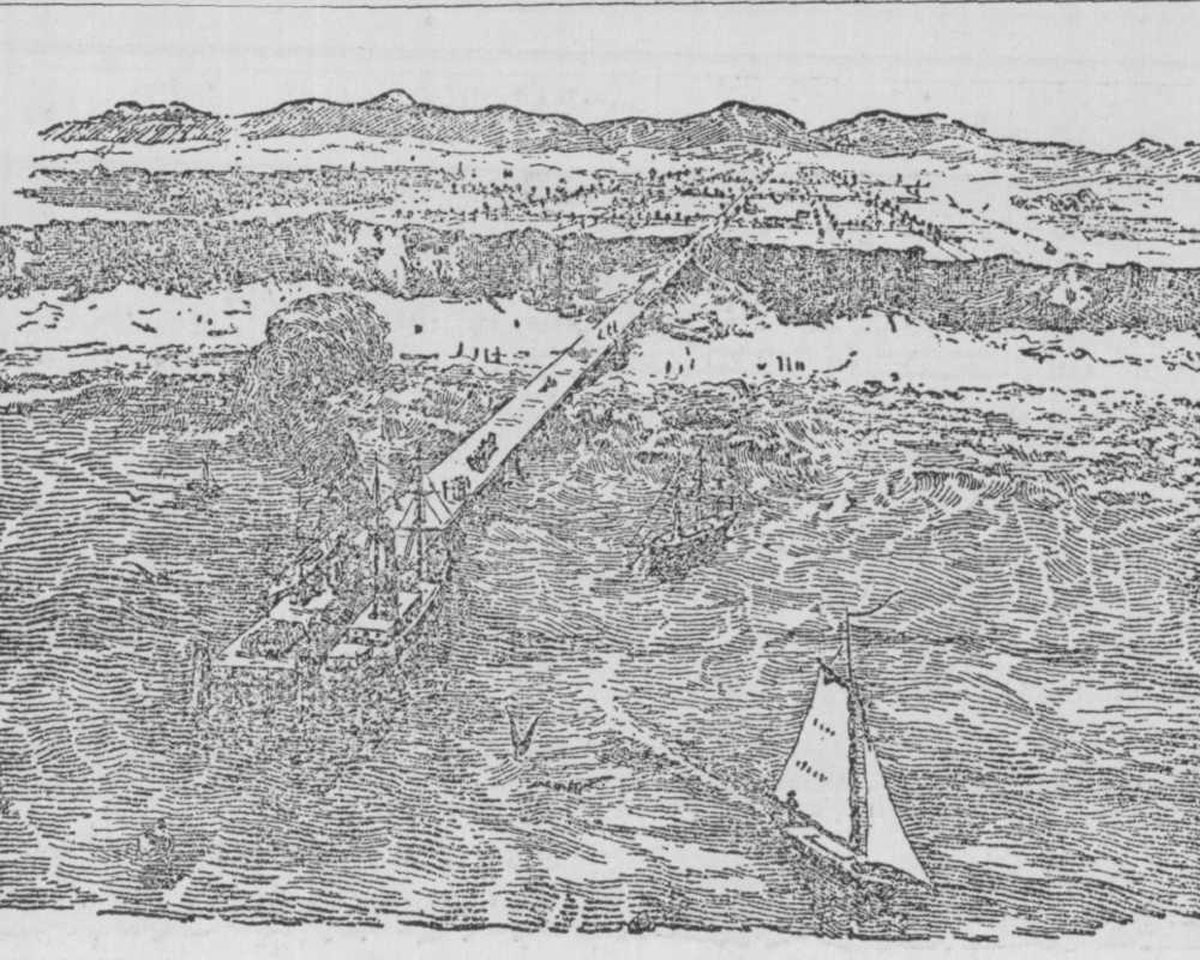
Sketch of the proposed Oceanside Pier from the South Oceanside Diamond newspaper
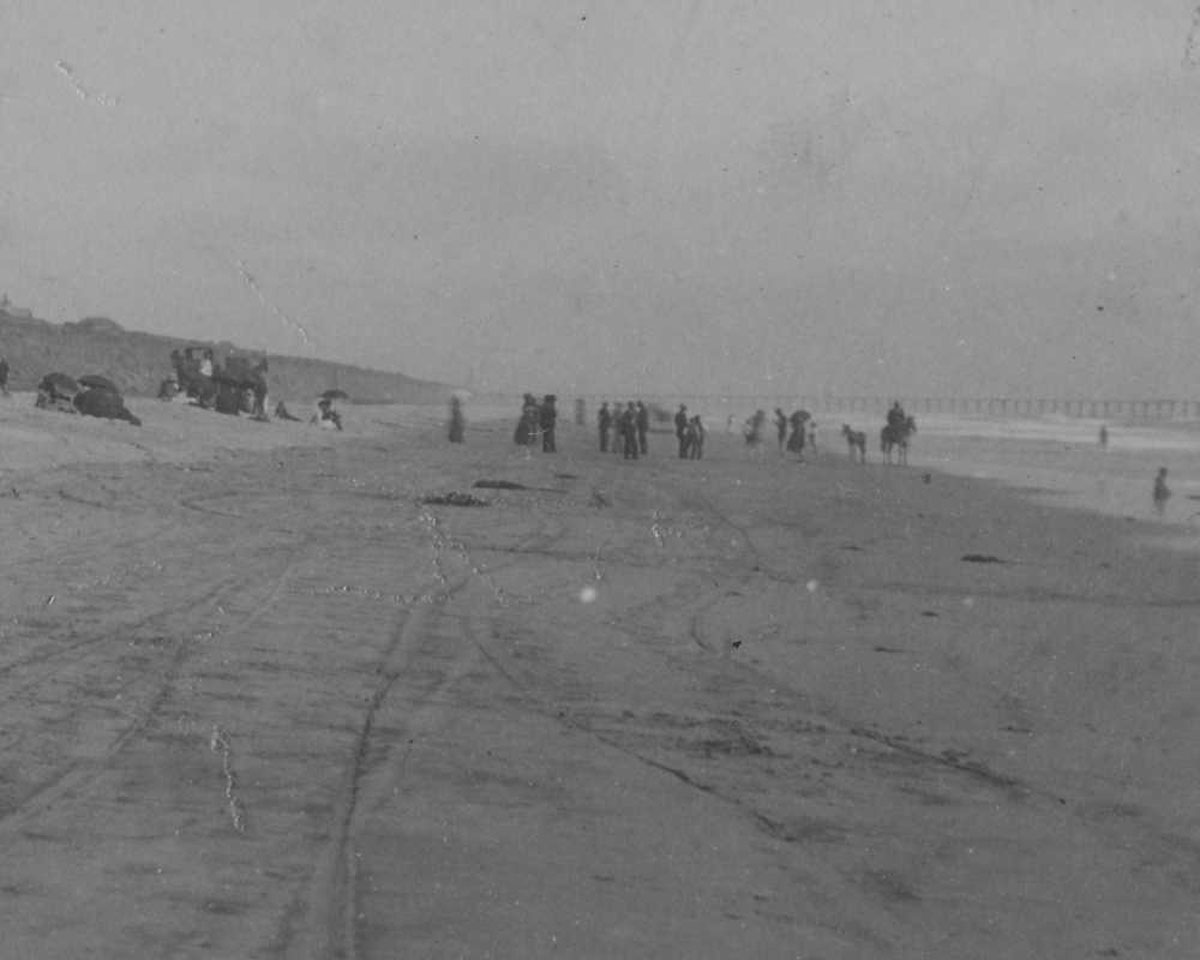
Only known photo of Oceanside’s first pier taken July 4, 1890. You can barely see it in the distance. Photo from the Oceanside Historical Society collection, courtesy Randy Carpenter.
Optimism, although dim, remained. In April of 1889, the wharf was scheduled for repairs and was going to be braced and the talk of steamers began once again. In August, Oceanside asked its citizens to raise an additional $4,000 and promised the wharf would be completed within 40 days when work commenced.
Records are missing and it is unclear as to if Oceanside’s wharf was ever completed but winter storms had reduced the wharf to 940 feet. On December 30, 1890 the final blow was dealt when the furious storms finished what was left and swept away all but 300 feet of the wharf. Newspapers from Los Angeles to San Diego reported its demise.
Oceanside’s first pier was gone but the dream was not forgotten. The wharf had become a fixture for the tiny town. If shipping vessels couldn’t dock, the wharf served another purpose, a fishing and pleasure pier.
Talk began immediately of building an iron wharf. It would take four years, but eventually Oceanside’s second pier was built at the end of Third Street (Pier View Way) in 1894.
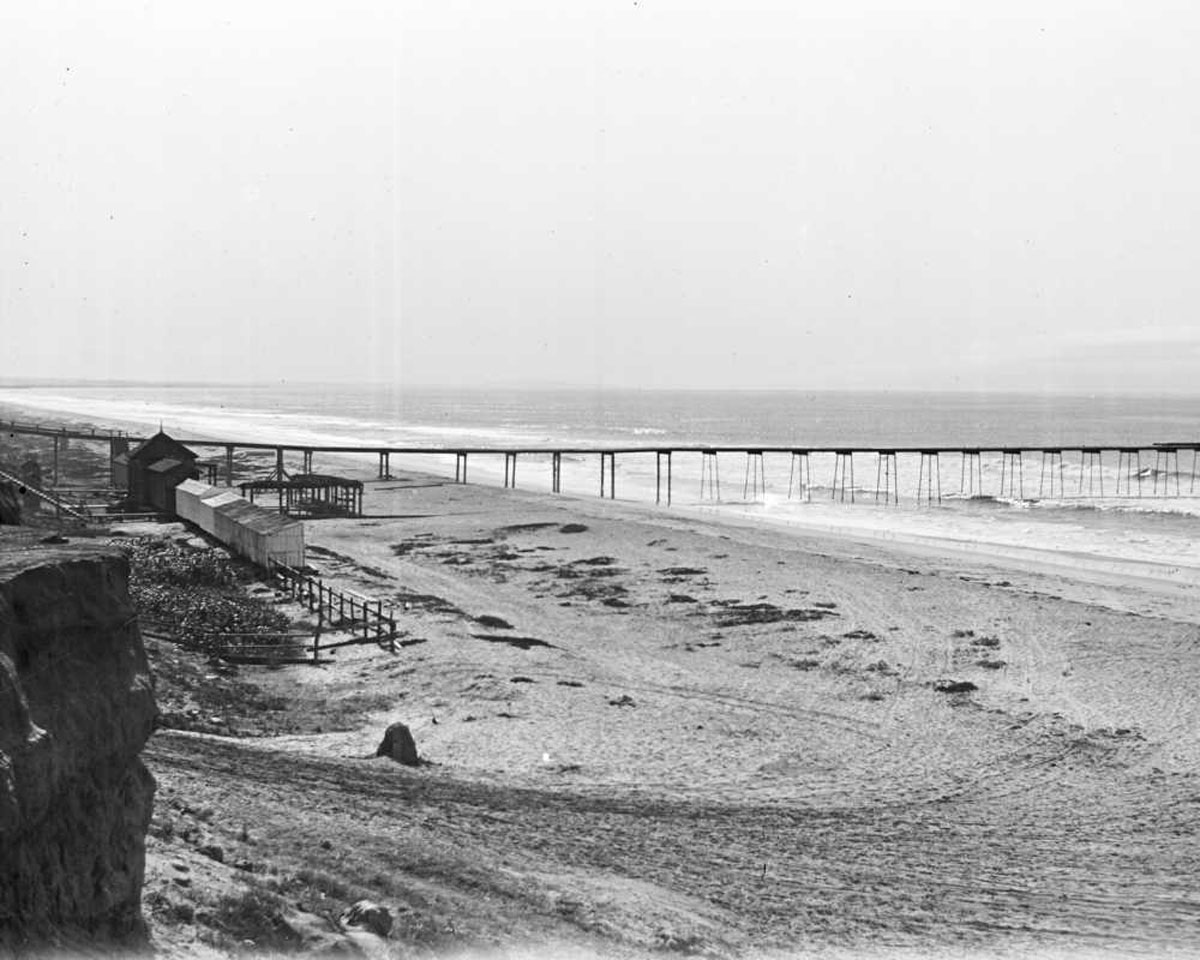
Oceanside’s 2nd pier, under construction in 1894. Photo from the Oceanside Historical Society collection
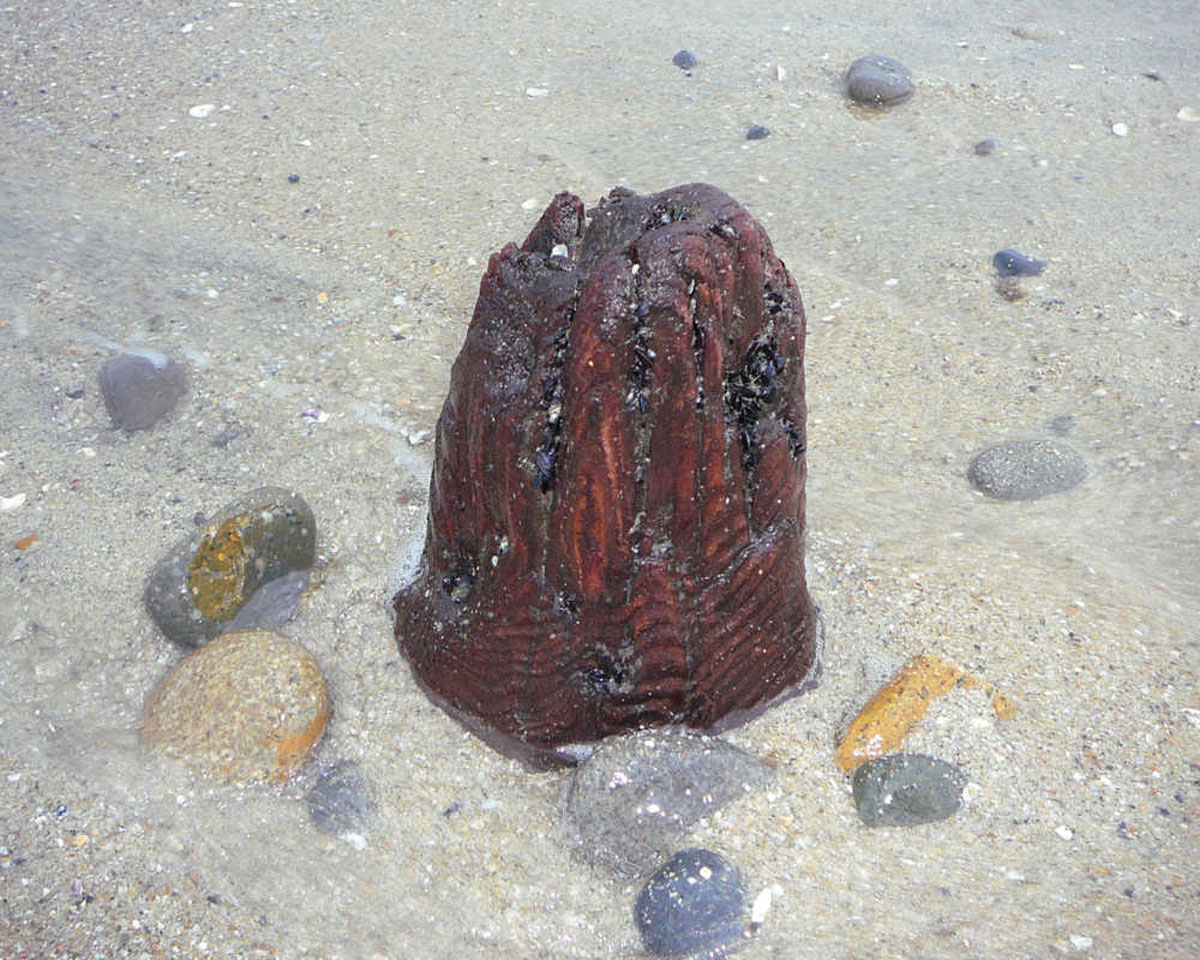
Close up of pier piling in 2012
Over the years we have had six piers, with our present pier being dedicated in September 1987. We are proud of our beautiful pier. We are equally proud of the citizens who have persevered and have dared to dream. Oceanside has always loved its pier and it would not be the same without it.
The next time you walk the Strand, stand at the end of Wisconsin Street and look. During a low tide you might just catch a glimpse of those pilings. The pilings are placed 29 feet apart, (which would have provided a rather narrow decking) and a row of center pilings helped to brace it. Ten pilings were visible on June 7, 2012, at a minus 1.2 tide. They appeared again a year or so later. On June 25, 2020, the low tide exposed the pilings again.
Those worn down nubs of wood are all that is left of Oceanside’s first pier, but they represent the ambition and undying vision of Oceanside.

Kristi Hawthorne has been a resident of Oceanside since 1983, began volunteering for the Oceanside Historical Society in 1987 and has served on the board of the Oceanside Historical Society for over 30 years and as president since 2002. She conducts Downtown History Walks for the public each year and presents regular historical programs at the Oceanside Public Library. She is known as the “historian” of Oceanside, writing a history book entitled “Oceanside, Where Life is Worth Living.” Kristi has been an avid supporter of Oceanside, proud to live and work in the City which she loves and has raised a family with her husband. Her blog, Histories and Mysteries, provides readers an in-depth look at people, places and events in our City’s history.
Published: January 21, 2022
